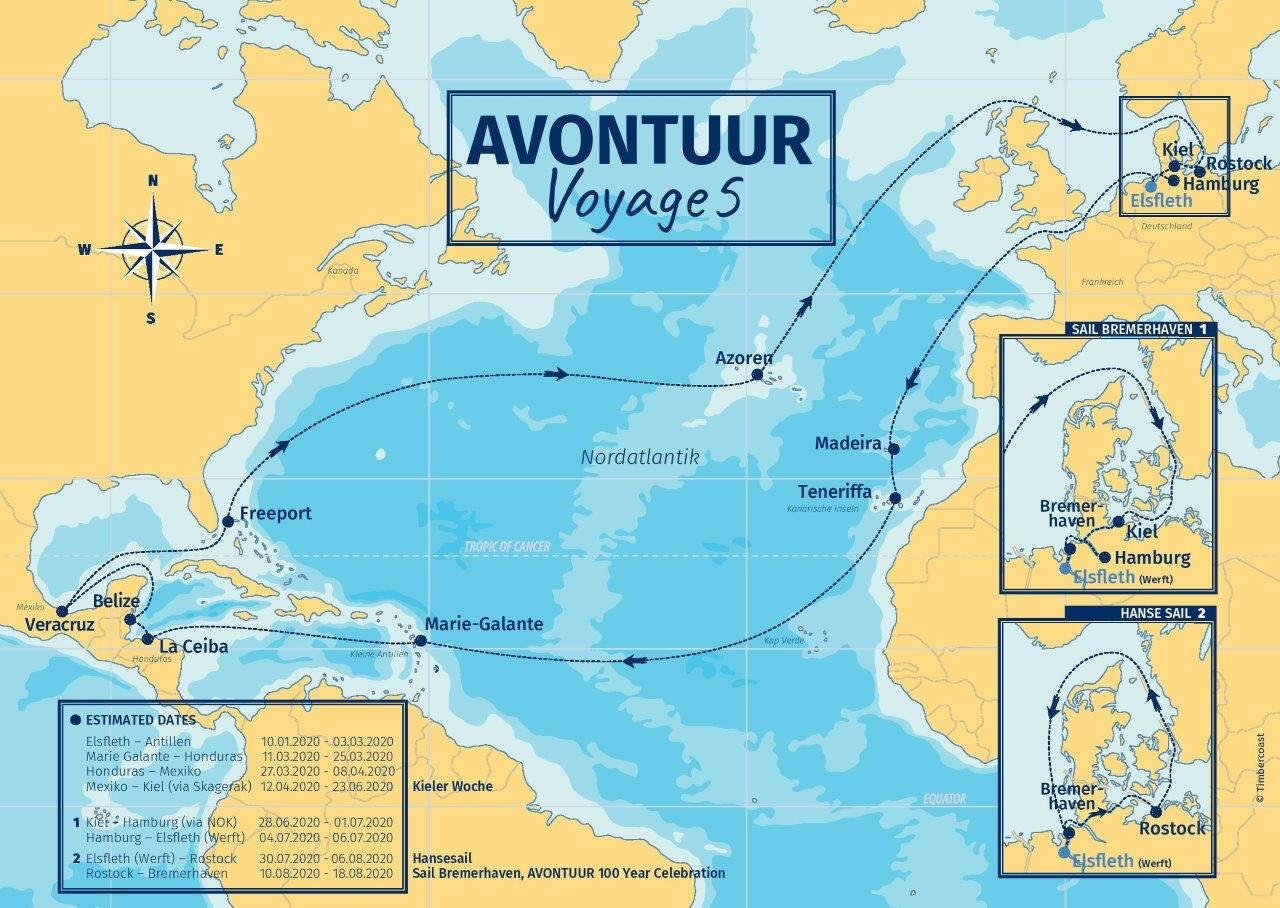My Sailing Avontuur Across the Atlantic Starts – with Waiting
One of these days, I will join the schooner Avontuur at Santa Cruz de Tenerife to sail across the Atlantic Ocean. Or so I hope at least. I should have joined her over two weeks ago, but she’s been delayed.
Avontuur left her home port of Elsfleth on Januray 17th, with a week’s delay. She had to wait for favourable winds to leave the Weser estuary near Bremen, where she was moored for the winter.
The vessel does have an engine and some carburant on board. So, she could have left on schedule without much effort. But that’s beside the point.
Timbercoast, a German shipping company that operates the vessel, sails with a purpose: Reducing carbon emissions from maritime cargo transport to zero. That’s easier said than done.
Once she passed the North Sea and the Channel, she spent nearly a week anchored at Douarnerez in Brittany. A storm over the Atlantic caused strong South-Westerly winds, causing headwinds exactly from where she was headed. As she’s an old ship built for cargo transport, not ocean racing, she does not sail close-hauled very well.
Despite these challenges, this is far from Avontuur’s maiden voyage. In 2020, she celebrates two important anniversaries.
Firstly, she turns a hundred years old. This makes her an ancient vessel in comparison with most merchant marine vessels, which commonly have a life-span of some twenty-five years.
Secondly, she will complete her fifth voyage as a cargo vessel for Timbercoast, the company founded by captain Cornelius Bockermann.
Captain Bockermann was born in northern Germany and spent years working in Nigerian waters. After selling his business and moving to Queensland in 2013, he started exploring the possibility of starting a coastal trading business with a sailing vessel, to ship goods emission-free along the Queensland coast.
Finding a suitable vessel was not easy. Eventually, he bought the Dutch vessel Avontuur (which means “adventure”, as you’ll surely have guessed) which needed work to make her ready for ocean-going cargo transport. The shipyard of Elsfleth, just across the river Weser from where Bockermann grew up, won the contract for these works.
Upon completion, Avontuur started sailing between Europe, the Caribbean, and Central America. In doing so, Avontuur joined the Tres Hombres, another sailing cargo vessel, in transporting goods across the Atlantic.
While setting up a sailing cargo company is a daring venture, Bockermann is not the first to do so. The Dutch company Fairtransport, which operates vessel Tres Hombres , has been shipping cargo under sail since 2009.
Tres Hombres has since inspired several more sail cargo ventures, including Ceiba, a new purpose-built wooden sail cargo vessel that is currently under construction in Costa Rica (which I will visit after disembarking Avontuur).
Avontuur’s own history is a source of inspiration too. Captain Paul Wahlen, a previous owner, sailed the vessel as a cargo ship from around 1980 until 2004, when he retired and sold the vessel. Captain Wahlen was one of the very few people to keep emission-free sailing alive, well after writers like Alan Villiers (an Australian tall ship captain who wrote many a book about the craft) and Eric Newby (a travel writer who sailed on “The Last Grain Race” that shipped South Australian grain to Europe by sail) declared sailing cargo vessels extinct.
Currently, Avontuur is on her way to sail around the Atlantic in about five months. She will load a full hold of mixed cargo, amounting to some eighty metric tons. This includes cacao from Belize, coffee from Mexico, and rum from Marie Galante. All the while, she sails korn (a spirit) from Germany, as the sailing journey does wonders for the ageing process.
Meanwhile, carnival is about to start in Tenerife. Which will inevitably delay our journey more. But the crew that have sailed Avontuur all the way from Germany will surely appreciate their upcoming shore leave before setting sail again.

Image: Timbercoast
The products Avontuur ships are not basic necessities. They are luxury goods we could very well live without. And her loading capacity is limited as compared to the gigantic container vessels that can load up to twenty thousand twenty-foot containers.
Moreover, cargo vessels under sail won’t be able to replace the massively polluting container vessels that transport nearly everything we consume. But that’s not their aim. They serve to prove that an alternative to heavily polluting cargo vessels running on fossil fuel is feasible. And in showing that, they get us to talk about shipping emissions. It’s high time we do.
It wasn’t until 2018 that the International Maritime Organization set a first ever emissions target for the shipping industry. And it’s far from certain we’ll meet their goal, even if their target is not nearly ambitious enough to keep global warming under 1.5˚C.
Sail cargo initiatives are diverse. But their shared message is clear: Shipping needs to decarbonise and create fair working conditions. But most of all, we need to ship infinitely less. Because shipping emissions are a huge problem, because collectively we consume so excessively much.
I’m sailing along with Avontuur – and later with other sail cargo vessels – to find out what these sailing climate activists are trying to accomplish, what drives them, and if their ventures can be scaled up to create a sizable fleet of sailing cargo vessels.
When on board, I’ll be a shipmate, because there are no passengers on board. I’ll have to work to earn my food and bunk (or so I hope!) on a watch-system. This means that I’ll be on watch for four hours, and off for eight, and that twice a day. While I’m off watch, I’ll try to sleep. Because whenever the captain calls “all hands on deck”, I’ll need to get up – whether eating or sleeping – and work.
In between, I’ll try to read. One of the books I’ve packed is Ian Baucom’s Specters of the Atlantic: Finance Capital, Slavery, and the Philosophy of History. Because while looking at the future of sailing cargo vessels, it’s good to understand their past as well. And what better time to learn about the Atlantic’s dark maritime history than when crossing it?
–
Follow my Instagram account for updates (whenever I have a connection, which won’t be until I disembark).
